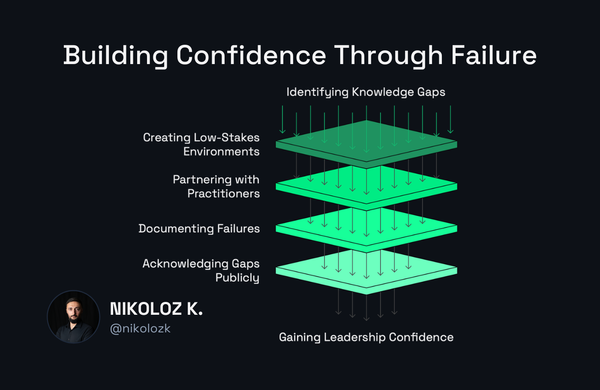Navigating Burnout in Cybersecurity: A Guide for CISOs

Nikoloz Kokhreidze
Explore why burnout in cybersecurity is rising and how CISOs can effectively manage this pressing issue. Learn proven strategies for productivity in your team.

Today, I want to discuss the topic that we rarely discuss - burnout in cybersecurity and how CISOs can navigate this complex topic to support their teams and enable productivity.
Before we jump in, let's talk data:
- According to a survey of 311 cybersecurity professionals taken at the Black Hat Europe expo, 66% of the respondents claimed to have experienced burnout in the year. Over 50% responded that workload was the most significant source of stress in their positions, followed by 19% who cited management issues, 12% pointing to complex relationships with colleagues, and 11% suggesting a lack of job satisfaction. (source).
- Cybersecurity practitioners are stretched thin and overworked due to a worsening talent shortage and increasingly active and sophisticated attackers. This leads to burnout and a need for a better work-life balance (source).
- Cybersecurity teams are suffering from the economic squeeze, with 63 percent of US security professionals having their department's budget cut in 2023. This leads to burnout and could result in workers quitting (source).
- CISOs and security teams face mounting responsibility and pressure, leading to burnout. This unspoken toll of rising cybercrime is impacting the resilience of cybersecurity professionals (source).
Understanding Burnout in Cybersecurity
So what is burnout? Burnout is a state of emotional and mental exhaustion linked to prolonged professional stress. It is a state where an individual has feelings of inadequacy, decreased performance, lacks motivation, and experiences anxiety and chronic fatigue.
Not only is burnout, not fun, but it can also lead to major health complications such as depression, sleep disturbance, neglecting personal needs, and work-life imbalance to the point where an individual spends much more time on work tasks at the expense of personal or family time.
In summary, burnout is bad for you and the people around you.
Top 10 Factors Contributing to Burnout in Cybersecurity
In the context of cybersecurity, depending on where you work and who you work for, several factors can contribute to burnout.
High Workload
Cybersecurity professionals are often required to manage multiple tasks and responsibilities simultaneously, including monitoring networks for suspicious activity, responding to security incidents, and implementing new security measures.
On-Call Duties
Being on-call means a professional must be ready to respond to emergencies anytime, often outside regular working hours - as an unspoken rule, security incidents usually occur on Friday evenings or weekends. This can disrupt personal time and make it difficult to disconnect from work.
Lack of Resources
Cybersecurity is not easy, especially when you lack resources. A robust cybersecurity program requires significant human resources, talent, technology, and infrastructure investment. While throwing money at security problems and expecting it to get solved by itself does not really work, throwing no or low amount of money is a guarantee to failure. Therefore, if the allocated security budget is insufficient or not correctly distributed, it will directly impact the team's performance and productivity, leading to increased stress levels.
Increased Vulnerabilities
Lack of resources and limited budgets not only impacts the people but also introduces gaps in the security infrastructure, leading to increased vulnerabilities. Since cybersecurity professionals must constantly deal with threats and incidents, more vulnerabilities will further affect the team's mental health.
High Stakes
In cybersecurity, the stakes are always high! Cybersecurity professionals are responsible for protecting sensitive data and systems. A single mistake or oversight can lead to significant damage, including data breaches and financial loss. The constant awareness of this risk and the inability to treat those risks can create a high-stress environment.
Rapidly Changing Threat Landscape
Nothing is static and this is especially true in our field. Cybersecurity threats constantly evolve, and new technologies emerge all the time, requiring professionals to learn and adapt quickly and continuously. There is a strong need for constant learning and adaptation, leading to continuous stress.
Lack of Recognition
Cybersecurity work is often behind the scenes, and professionals may not receive recognition for their work unless something goes wrong. While the work is one of the most interesting and exciting, sometimes it might feel like a "thankless job."
Lack of Control
If cybersecurity professionals feel they have little control over their work or the outcomes of their efforts, this can lead to feelings of helplessness. This is often true when security projects and efforts heavily depend on other teams, such as Engineering, Development, or IT.
Role Ambiguity
In Georgia, my home country, we have a saying "ყველაფერჩიკი" [kvela-fer-chiki], this means a person who is forced or has to do every task at work on their own. This is not where you or your team want to be. This can happen when roles and responsibilities are not clearly defined, leading to confusion and stress. In such situations, cybersecurity professionals may be unsure of their duties or feel pulled in multiple directions, contributing to burnout.
Organizational Culture
If an organization does not prioritize mental health or provide support for stress management, this can contribute to burnout. This can include a lack of flexibility, high expectations without adequate support, and a lack of understanding or empathy from management.
Now that we have covered the contributing factors to burnout, let's talk abut about the impact.
The Impact of Burnout on Cybersecurity
Burnout can lead to an increase in mistakes. In cybersecurity, where precision is crucial, these mistakes can have profound implications, including potential security breaches. As professionals wrestle with the cognitive and emotional exhaustion accompanying burnout, their attention to detail can suffer.
One of the most significant impacts of burnout is the potential for higher turnover rates. Faced with the stress and exhaustion of burnout, professionals may opt to leave their positions, resulting in a loss of experienced and skilled professionals. This turnover can weaken the cybersecurity team and impact the organization's ability to respond effectively to cybersecurity threats.
The cumulative effect of decreased productivity, increased mistakes, and higher turnover rates can significantly compromise an organization's security posture. With less effective work, more errors, and a loss of skilled professionals, the organization's ability to protect against and respond to cybersecurity threats can be weakened. All of these leads to a significantly increased risk of security breaches and potential damage to the organization's reputation and financial status.
The Role of the CISO in Addressing Burnout
Whether we like it or not, unfortunately, burnout is a common phenomenon in cybersecurity. The relentless pace, the high stakes, and the constant need for vigilance can take a toll on even the most dedicated professionals. However, with the right strategies, CISOs can help cybersecurity professionals maintain a healthy work-life balance and prevent burnout.
6 CISO Strategies for Addressing Burnout
As leaders, Chief Information Security Officers (CISOs) play a vital role in establishing a healthy work environment and avoiding burnout in their teams. While not tailored to unique cases, I will provide a few strategies that CISOs can utilize to tackle the challenge of burnout.
Lead by Example
CISOs, as leaders, should demonstrate a healthy work-life balance themselves. This includes setting clear expectations about work hours, encouraging employees to take breaks and time off, and promoting a culture that values work-life balance. Since cybersecurity professionals often work long hours in a high-stress environment, promoting reasonable work hours and avoiding a "crisis culture" can help reduce stress and prevent burnout.
Avoid a "Crisis Culture"
Let's face it, cyberattacks, risks, and vulnerabilities are not going away anytime soon, and neither we have a silver bullet to secure any organization completely. Nothing is perfect, and neither will ever be. Therefore, CISOs must ensure they and their teams fully understand that they cannot protect from every attack or solve every problem. Instead, cybersecurity teams should aim to address the highest risk challenges - ask, what can I do today, next month, or this year that can deliver the most significant positive impact for the security posture of my organization and focus on that. This leads me to one of my favorite topics: prioritization and execution.
Prioritize and Execute
Just like any leader, CISO must be able to identify top priorities and effectively communicate those with their team and stakeholders. Next, CISO must be able to define a strategic approach to address those priorities from top to bottom and define execution steps for the team. You can learn more about Prioritization and Execution in my article "The Power of Extreme Ownership".
Advocate for Mental Health and Enable "Venting"
CISOs are vital in advocating for their teams' mental health. This can be accomplished by promoting open conversations about mental health, reducing the stigma of seeking help, and providing resources for stress management and mental health support. It is also essential to enable "venting" so that employees are encouraged to find time with their peers to discuss common problems and vent about anything, including CISO and the employer. This allows team members to associate themselves with each other, find support and perhaps tighten the bond.
Implementing Flexible Work Arrangements
According to a Harvard Business School study, 81% of surveyed professionals either don't want to return to the office or would prefer a post-pandemic hybrid schedule. In cybersecurity, flexible work arrangements can take various forms, including telecommuting, flexible work periods, compressed workweeks, job sharing, and reduced hours arrangements. These arrangements allow employees to balance their work and personal lives better, reducing stress and the risk of burnout.
Promote a Culture of Continuous Learning
CISOs can also help prevent burnout by fostering a culture of continuous learning and professional development. They must encourage a learning mindset among your team members. This can be achieved by integrating learning into your employees' daily routines. Short, focused lessons or microlearning modules can also help reinforce key concepts and best practices without overwhelming team members, leading to better retention and security-aware culture. Another option is to provide an upskilling program for all team members, regardless of their role, and enable those in security roles to deepen their understanding and stay up-to-date with the latest skills.
Conclusion
As we learned, burnout in cybersecurity is a significant issue that requires immediate attention. The high-stress environment and the industry's relentless pace can lead to severe mental health issues among cybersecurity professionals. As CISOs, it is crucial to recognize the signs of burnout and take proactive steps to prevent it.
Leading by example, promoting a healthy work-life balance, advocating for mental health, and fostering a culture of continuous learning are all strategies that can help mitigate the risk of burnout. Implementing flexible work arrangements can also allow employees to manage their work and personal lives effectively.
However, it's important to remember that addressing burnout is not a one-time effort. It requires continuous attention and commitment from both the leadership and the entire team. Regular check-ins, open communication, and a supportive work environment are key to ensuring the mental well-being of your team.
In the end, taking care of your team's mental health is not just about preventing burnout - it's about creating a work environment where everyone can thrive. By prioritizing mental health, you're improving your team's well-being and strengthening your organization's overall security posture.
Remember, a healthy team is a productive team. And in the world of cybersecurity, that can make all the difference.
Did you like this article? Which strategies have you used to mitigate burnout risks? Share those in comments and subscribe for more content like this.


